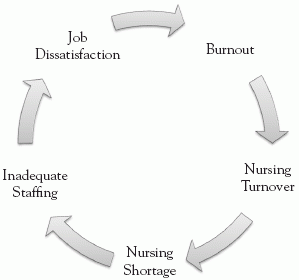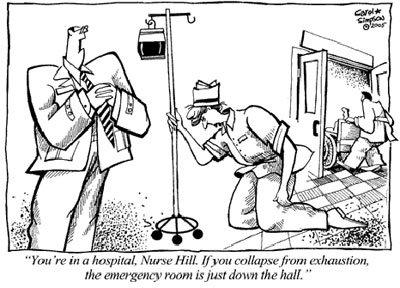
Compassion fatigue is a phrase I have hearing with an increasing frequency. Throughout my career, I have worked at three different hospitals with many fellow nurses at different stages in their careers with varying personalities. Occasionally staff would verbalize concerns about the hospitals and the staff and the management we work with. Even I, myself, had found I had reached a point where I was not enjoying my job as much as I had hoped. I decided to research the negative feelings I was having towards my job, and found many possible causes. One of which was compassion fatigue, I have provided this website to shed some light on what compassion fatigue is and to let you know, not all hope is lost.
WHAT IS IT?
In 1995, Charles Figley first noted that compassion fatigue and secondary traumatic stress disorder were the same thing, people identified to which ever term they felt has less of a stigma. (Austin, W., Goble, E., Leier, B., & Byrne, 2009) Another term which has been around is burnout. Each of these terms have been used by many studies in varying context. Depending who's work you are reading, they can be varieties of the same thing. Coetzee and Klopper (2010) state that "Compassion fatigue is the final result of a progressive and cumulative process that evolves from compassion stress after a period of unrelieved compassion discomfort, which is caused by prolonged, continuous, and intense contact with patient, the use of self, and exposure to stress" (pg 237).
Secondary Traumatic Stress Disorder is seen mostly in nurses which care for victims of violence and their families. They hear the stories, see and can grieve with the families. This occurs when the nurse is unable to remove his or herself from the situation and ends up losing sleep over what has happened to these patients and their families. There are incidences of the nurse feeling as though it was her who was in these situations. They develop symptoms of post-traumatic stress disorder including flashbacks. (Coetzee & Klopper, 2010)
Burnout has been described both as a symptom of compassion fatigue and as a similar but separate problem. In a study by Potter, Deshields, Divanbeigi, Berger, Cipriano, Norris and Olsen (2010) compassion fatigue is talked about as an emotional reaction as opposed to burnout which is a perceived imbalance of supply and demand; that there are a lack of needed resources.
On the other side there is compassion satisfaction which has been found to have the complete opposite results in the same situations as when compassion fatigue results. It has yet to be found what leads the variation in results. Coetzee and Klopper (2010) note that the nurse is able to connect with the patient and have meaningful and purposeful interactions with the patients.
Austin et al (2009) note that there are stressors nurses are currently facing; resource shortages, "marginalization, with recent reforms having altered the health care to such a degree that the environment itself may place professionals at greater risk" (Caulfield 2002). In the research done by Austin et al (2009), they found that Peters et al (2004) had nurses reporting working environments as "...dominated by medical or business values where nursing perspectives were marginalized"(pg. 200). These work places lead to a lack of meaningful communication between patient and nurse which deters the nurses to act ethically and leading to a moral suffering.
There is also an element of societal influence which has been attributed to the development of compassion fatigue. There is over exposure of social problems broadcast by the media. Austin et al noted Western societies have become postemotional, which is general cynicism and social disconnect from those who surround them. Those who are exposed to this feel emotions with out being able to react to them. "Within a post emotional society, compassion is negated and compassion fatigue moves from being an individual phenomenon to affecting the public at large." (Austin et al, 2009, pg 198)

There is a cycle that has resulted from compassion fatigue and burnout. It leads nurses to leave the job, call out more frequently, and no longer enjoy their job which leads to an increased need for nurses, which there is a shortage of, but this in turn leads to additional stress at work leading to worsening burnout and compassion fatigue.
Potter et al (2010) note that compassion fatigue is a sudden onset emotional response, where as Coetzee and Klopper (2010) report that there is a progression from discomfort, to stress then to fatigue.
WHAT IT FEELS LIKE?
Symptoms which have been identified in research by Coetzee and Klopper (2010) and Austin et al (2009) of compassion fatigue include:
- Chronic fatigue
- Irritability
- Being desensitized
- Dread of going to work
- Desire to leave the job
- Aggravation of physical ailments
- Lack of joy in life
- Poor judgment
- Emotional exhaustion
- Increased proclivity to accidents
- Apathy

When research was done by Austin et al (2009) with nurses who identified themselves as having compassion fatigue, the nurses described it as:
~ 'Running on empty' - Feeling so fatigued they were unable to give anything to their patients
Unable to feel rested after working, losing sleep due to thinking about work. "Fatigue occurs when one does not 'bounce back' from tiredness" (Austin et al, 2009, pg 203).
~ 'Shielding myself' - also referred to as distancing one self.
Exhibited by focusing more on skills than the patient or by providing just the basic skills. It was discussed that this can dehumanize the nurse. The end result of this can be leaving the field entirely. This can filter into the nurses personal lives and lead to unwillingness to reach out to people.
~ 'Being Impotent as a Nurse'
"Hopelessness regarding meaningful change permeated the participants descriptions" (Austin et al, 2009, pg 205) It is also noted they had no longer expected a change for the better in their situations.
~ 'Losing Balance: It Overwhelms Everything' - this took all their energy and effected every part of their life. Unable to leave work at work and have it effect the work - home life balance.
~ 'The Kind of Nurse I was' - No longer 'engaging' with the patients, no longer feeling certain about what they were doing, and not loving the job anymore.
~'Trying to Survive' - No longer fulfilling their own goals of being a nurse. "searching for way of addressing their inability to practice the way they felt they ought within the realities of the healthcare system." (Austin et al, 2009, pg 209)
HOW TO HELP IT
Solutions for compassion fatigue:
- Changing the venue in which you work
- Watch patients recover
- Cutting back on hours
- Making an effort to get back into the activities you used to do
- Continue with educational opportunities
- Remember the good things from the past
- Get professional support
o Employee Assistance Programs
o Accelerated Recovery Program by Eric Gentry http://www.compassionunlimited.com/pdf/PowerPointPresentation.pdf
o Mindful-Based Stress Reduction http://www.mindfullivingprograms.com/onlineschefees.php
References
Austin, W., Goble, E., Leier, B., & Byrne, P. (2009). Compassion Fatigue: The Experience of Nurses. Ethics & Social Welfare, 3(2), 195-214.
doi:10.1080/17496530902951988
Coetzee, S., & Klopper, H. (2010). Compassion fatigue within nursing practice: a concept analysis. Nursing & Health Sciences, 12(2), 235-243. doi:10.1111/j.1442-
2018.2010.00526.x
Potter, P., Deshields, T., Divanbeigi, J., Berger, J., Cipriano, D., Norris, L., & Olsen, S. (2010). Compassion fatigue and burnout. Clinical Journal Of Oncology Nursing,
14(5), E56-62. doi:10.1188/10.CJON.E56-E62

